A while back, I posted a deconstruction of the cover art for the Journey album Escape, hoping that it would be the first in a new series called “Album Covers That Blow My Mind.” Well, a year later, that second entry is finally here! I know, it’s been a while, but don’t worry, it was worth the wait.
Ladies and gentlemen: Meat Loaf’s Bat Out of Hell.
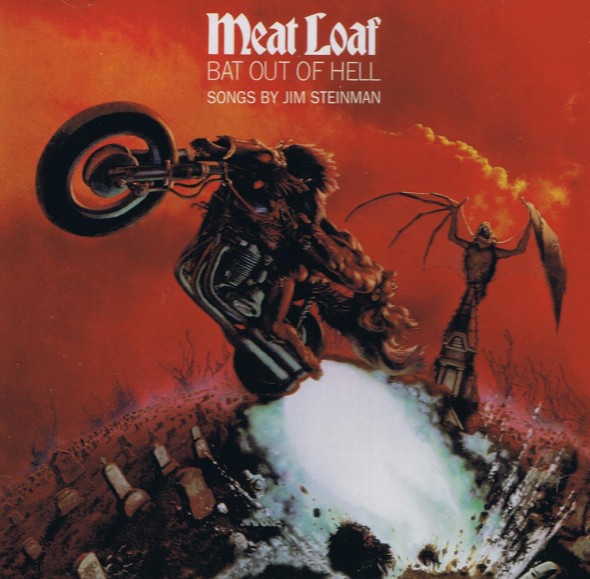
I know, your mind is blown, right? Once you’ve recovered, follow me after the jump to Overthink the Hell out of this.
Fortunately, we actually know a fair amount on the origins of this spectacular image. According to “Q Magazine: The 100 Best Record Covers,” Jim Steinman, who came up with the album’s concept and wrote the music, acquired the services of artist Richard Corben based on his track record of sci-fi and fantasy art. Everyone knew what they were getting into with this project. In other words, it’s no accident that a naked, muscle-bound man rocketing out of hell on a horse-motorcycle appears on the cover of this album.
But we’re not there yet. Let’s take it from the top, specifically, with…
The Fonts

The choice of font for “Meat Loaf” seems obvious at first. You probably have a similar font on your computer, and you probably used it when designing your Halloween Party invitations. It’s a type of “Gothic” script, so named because it came from the parts of Europe that the Gothic tribes inhabited, and also because the Italians who coined the term considered such people to be “barbaric.” Somewhere along the line, the term “gothic” came to encompass broad swaths of medieval European culture, and when the castles associated with medieval European culture crumbled and became ruins, people began to associate “gothic” with the supernatural, darkness, and melodrama.
That’s a super-truncated history of the phrase “gothic,” but you get the idea. If you call an album Bat out of Hell and fill it with epic, melodramatic songs, you want to create the appropriate imagery to go with it, and part of that imagery is an awesome font.
But wait. Why is “Meat Loaf” in the awesome gothic font, but “BAT OUT OF HELL” in a boring, nondescript san-serif typeface?
Here we begin to examine this album’s relationship with our good friend, irony. Lest you think that this combination of art and music was done entirely seriously, remember this: of course there’s going to be some level of irony when the name of the singer on your album is called MEAT LOAF. I mean, when you think of Meat Loaf, either the man or the dish, the words “gothic” and “awesome” don’t immediately jump to mind:
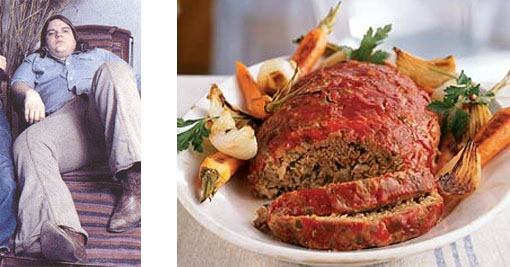
If you’ve listened to the album, and I hope you have, you’re well aware of the ironic, over-the-top nature of the lyrics:
I want you, I need you
But there ain’t no way I’m ever gonna love you
Now don’t be sad
‘Cause two out of three ain’t bad
Given this overall mood of the album, then, it’s no surprise that the name “Meat Loaf” gets the goth treatment. It’s meant to be ironic.
I wonder if anyone let Richard Corben in on the whole irony part. More on that later.
So now that we’ve explained the selection of fonts and found our first hints of irony, let’s move on to the substance of this fantastical scene, starting with…
The Landscape–or should I say–The Hellscape
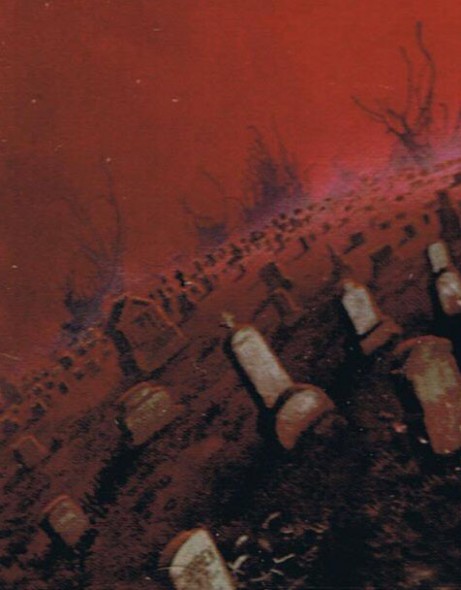
Why are there graves in hell?
No, seriously, why are there graves in hell? Hell isn’t supposed to be full of corpses buried in the ground, marked with tombstones by their loved ones. No, hell is supposed to be full of souls living out eternity in damnation.
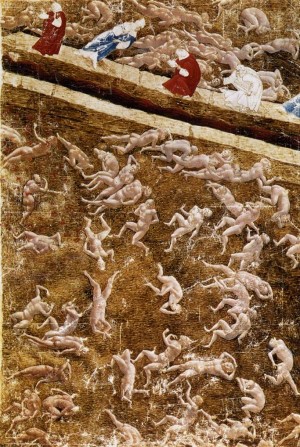
I don’t see any tombstones here. Satan surely wouldn’t have wasted time putting them all over the ground. (And besides, at union labor rates, they would have cost a fortune. But I digress.)
Obviously, they’re meant to be there for aesthetic’s sake–graves look cool, and they help to provide contrast between the surface of hell and the sky above–but is there any meaning to be taken from these?
Maybe hell is actually on earth. In fact, the lyrics to the title track, “Bat Out of Hell,” even speak to this notion of hell as less of a metaphysical afterlife and more of a inescapable state of being:
And I know that I’m damned if I never get out
And maybe I’m damned if I do
But with every other beat I got left in my heart
You know I’d rather be damned with you
Well, If I gotta be damned you know I wanna be damned
Dancing through the night with you
This poses an interesting question. If the hellscape we see depicted in this album cover is meant to be some sort of representation of reality–as opposed to the biblical underworld–then what’s that huge bat on a church supposed to represent?
The Bat on the Church
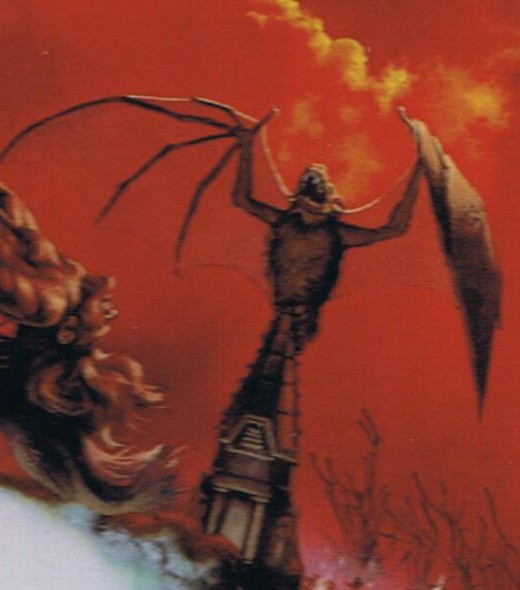
Also, why is the bat staying in hell when the name of the album is Bat Out Of Hell?
At this point, we need to acknowledge that Richard Corben had to have read the lyrics to at least the title track of the album before creating this artwork. This is most clearly evinced by the description of the motorcycle in the song, which is taken directly from the lyrics, “I’m gonna hit the highway like a battering ram on a silver black phantom bike.” (More on the bike later–we’ll get there, I promise!) This is important because of the context in which the phrase “Bat out of hell” appears. Specifically, the protagonist in the song is escaping “like a bat out of hell.” In other words, he’s moving so fast that even the bat, who is known for his velocity, is stunned at the scene and incapable of taking chase.
That explains why the bat isn’t leaving hell–to provide contrast to he who is leaving–but it doesn’t explain why the bat is on what appears to be a church steeple. For that, we return to our interpretation that this scene is some projection of hell-like elements onto a representation of earth. A church makes sense, given the presence of the graveyard. As for the bat, he represents the evil force that has overtaken everything on earth, including its holy places.
Again, we turn to the lyrics to support this interpretation:
The sirens are screaming and the fires are howling
Way down in the valley tonight
There’s a man in the shadows with a gun in his eye
And a blade shining oh so bright
There’s evil in the air and there’s thunder in the sky
And a killer’s on the bloodshot streets
Oh and down in the tunnel where the deadly are rising
Oh I swear I saw a young boy
Down in the gutter
He was starting to foam in the heat
Oh Baby, you’re the only thing in this whole world
That’s pure and good and right
These lyrics describe the extent to which evil has overtaken the world: there’s only one thing that’s pure and good and right in it–the protagonist’s love interest–and everything else is hellspawn. Hence the bat on a church in the middle of a graveyard.
So that leaves only one part of this image to unpack. Yep, I know you’ve been waiting for this:
AWESOME HORSE-HEADED MOTORCYCLE WITH RIPPED NAKED DUDE ROCKETING OUT OF HELL
 [Let’s pause the overthinking for a moment and appreciate how flipping sweet this image is.
[Let’s pause the overthinking for a moment and appreciate how flipping sweet this image is.
Done? Resume overthinking.]
As we saw before, Richard Corben took this image of the motorcyle and rider straight from the lyrics of the title track: “I’m gonna hit the highway like a battering ram on a silver black phantom bike.” Although there’s no highway to speak of in the picture (Roads? Where he’s going, he won’t need roads–the bike is a freaking rocket!), the bike literally is silver and black, and the horse’s skull gives it a ghostly or undead quality. The rocket-action speaks for itself (high velocity), which leaves only the ripped naked dude open for interpretation.
Now it’s time to bring our old friend irony back to the table. Compare the guy on the bike to the guy who sings this song:
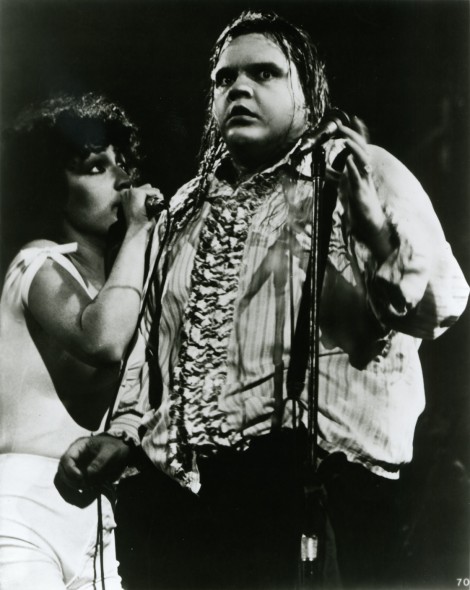
Now, I have no proof that the muscle-bound protagonist on the cover is meant to be a joke at the expense of the decidedly non-muscle-bound singer of the album. But I do know that the sum total of the imagery of the album cover suggests a fairly straight interpretation of the lyrics to the title track and the title itself. The art by itself is unironic, but it comes ironic with the comically gothic “Meat Loaf” emblazoned on the front (presumably done by someone other than Corben) and the lyrical content of most of the album.
I think it’s totally possible that Jim Steinman gave Richard Corben the title of the album, the lyrics to its title track, and instructions to make something “awesome,” knowing that he’d come back with cover art that would create an ironic contrast with most of the content of the album and its lead singer.
I have no evidence to back up this interpretation, save for what’s on the reverse side of the album sleeve:

I don’t know what’s going on in this picture, but I’m pretty sure that Richard Corben was not involved in any way.
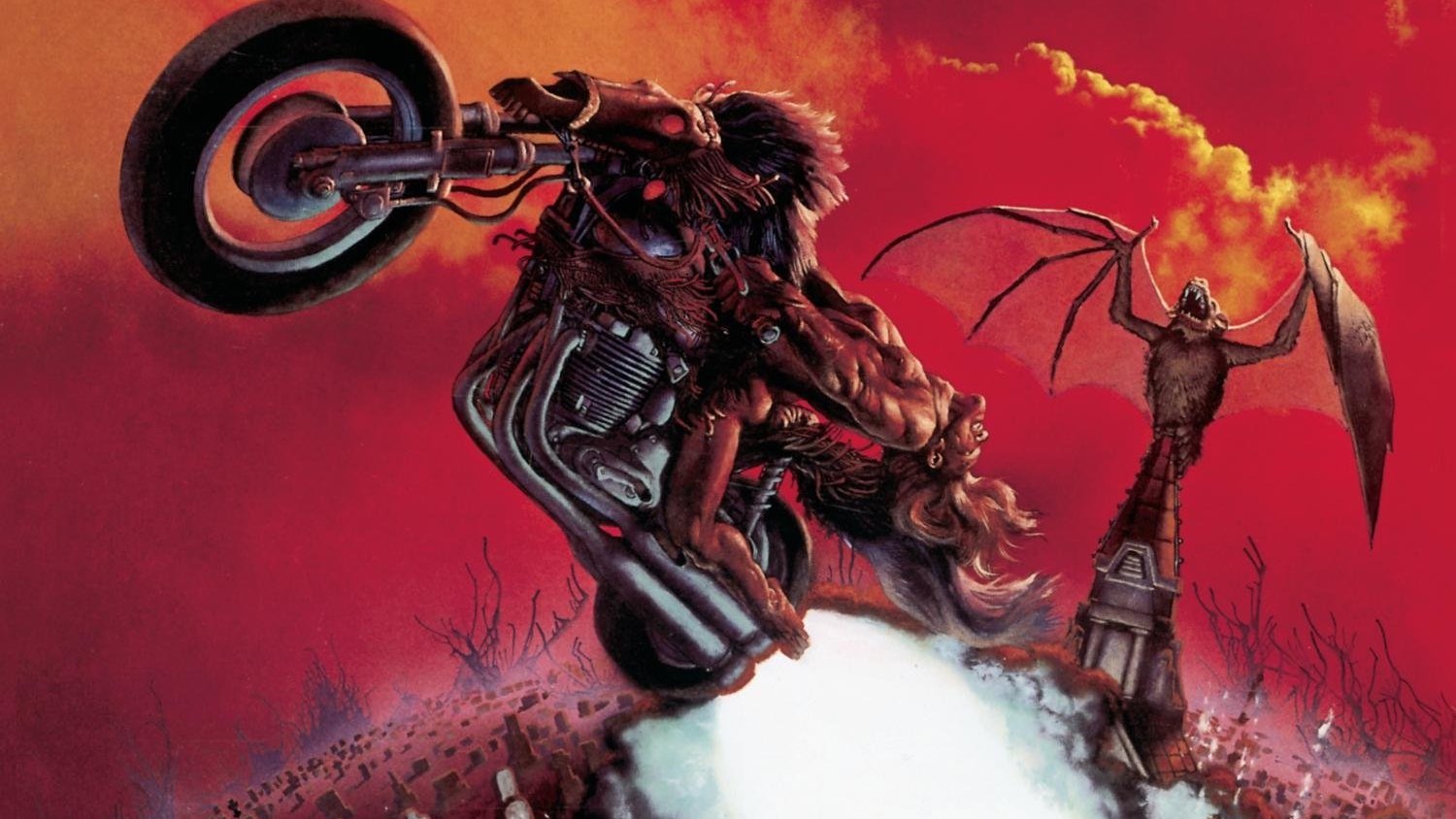
I always assumed that the motorcycle driver is not just taking off, but that he has broken the roof of Hell and into our world (our supernaturally apocaliptic red world). Instead of a zombie crawling clumsyly from his grave, he comes back in style.
PS: Great site, excuse my English as it is not my mother language. Not even my second cousin language :-P
I never interpreted this scene as occurring in Hell, but rather in a graveyard directly above Hell. The rider is clearly bursting through the ground, “out of Hell”, and the I always saw the giant bat as some sort of demonic gatekeeper or hellish sentinel, who in mere moments will give chase to the “ripped naked dude”.
Sam: give chase LIKE A BAT OUT OF HELL?
Agree with above comments. Maybe it’s the grave of Dr. Faustus that functions as a portal to hell. I always saw the bat as Satan himself and the biker as a sort of Satan’s Little Helper or, more to the point, a Hell’s Angel.
I’m newly intrigued by the fact that ripped naked dude is in no way ‘riding’ the bike; he’s being yanked forward holding on for his dear, well toned life.
Anyway: great album cover to Overthink, I really look forward to reading more in this series. Can we leave requests?
Yes! Please do leave requests. I hope this becomes a more frequent series along the lines of the Musical Talmud.
Rush – Permanent Waves
Def Leppard – Pyromania
Supertramp – Breakfast in America
Led Zep – Houses of the Holy
Van Halen – 1984
RHCP = BloodSugarSexMagik
Spinal Tap – Smell the Glove :)
Also, any Boston album cover
I guess it would have to be something by Storm Thorgerson. I.e. is the Muse – Absolution cover making reference to the rapture and similar dispensationalist eschatology.
I’m a big fan of Meat Loaf’s music. Everytime I go to karaoke, I always look to see if they added any new Meat Loaf tunes (I’m hoping for “Everything Louder than Everything Else.”)
So I was somewhat surprised to hear that Bat Out of Hell is meant to be ironic. Really? Is Meat Loaf basically The Darkness, pushing things to ridiculous extremes to be funny? I suppose the name suggests that this band is not taking itself remotely seriously. And yet, I don’t think every Meat Loaf song is meant to be taken as a joke. Rather, I’d say that these songs are sincere, but written by someone with a good sense of humor. So yes, a lot of Meat Loaf INCORPORATES irony, but that doesn’t mean that “I’d Do Anything For Love” is meant to be funny. I think Jim Steinman is deadly, deadly serious about making music that absolutely drips with emotion. A lot of people find his operatic style to be hilarious, but I don’t think he’s in on the joke.
Really? I agree it’s a real love song and not just a novelty, but man, there’s a double-entendre right in the chorus: “I would do anything for love, but I won’t do that”, surely implying some sort of sexual act, an interpretation that is later undercut by the song’s final lyrics (lyrics which actually don’t make much sense in the context of the chorus).
And certainly “Paradise by the Dashboard Light”, while again an impassioned song about teen love/lust, has parts that are obviously humorous: “we were barely 17 and we were barely dressed”; the use of the baseball play-by-play as a rather literal-minded representation of “running the bases”, and “I said I’d love her ’til the end of time/And now I’m praying for the end of time/To hurry up and arrive”.
I don’t think anyone could write the lyrics Jim Steinman did for Meat Loaf and not intend to be funny — he didn’t intend to write songs that were jokes or novelties, but they are definitely intentionally funny as well as heartfelt.
Now, on the other hand, “Total Eclipse of the Heart” seems deadly earnest, which makes it all the more unintentionally hilarious (especially the “Literal Video” version).
(And on a completely unrelated note, if I may be permitted a “Well, actually…”, when referring to fonts, the lettering style for Meat Loaf’s name is less-confusingly called blackletter, since in font terms “gothic” often refers to sans serif fonts (which of course are the aesthetic opposite of the highly ornamental blackletter).
I think you’re misunderstanding the chorus–
‘would you raise me up, would you help me down, would you take me right out of this godforsaken town? Would you take me places I’ve never been?’
‘I can do that.’
‘would you cater to every fantasy I’ve got, would you hose me down with holy water, if i got too hot? Woudl you take me places I’ve never been?’
‘yeah I can do that’
‘With all the territory I’ve been around, it’ll all turn to dust and we’ll all fall down. Sooner or later, you’ll be fooling around…’
‘No, I won’t do THAT‘….
The ‘I won’t do that’ clearly refers to the stupid things taht lovers do that undermine love if you listen to the lyrics closely–I’ll do anything for love, and in addition, I won’t do that thing that you worry may undermine our love’. The grammar is awkward as hell, but that is the clear intent.
Also, supposedly, Steinman actually cried when they removed a minute of motocycle revving out of the recording when they created the video cut, so I wonder how much humor he treated that song with.
Yes, that meaning of the chorus is made clear at the end of the song, but until then I think the chorus wording is meant to come off as a double entrendre. After all, given your interpretation above, the “but” in the chorus makes no sense, since the “but” is clearly meant as a restriction on the “anything [he] would do for love“, as in “I would do anything for love except for this particular thing”. Clearly “foolin’ around” is not something one would do “for love”. (Recasting the chorus as “I would do anything for love, but I won’t fool around” makes the problem clearer, as it in that case should be “I would do anything for love and I won’t fool around” or “I would do anything for love including not fool around”.) The grammar of the chorus is awkward because the chorus is written to be (humorously) misleading, with the referent for “that” ambiguous, and only clarified at the end of the song.
Maybe like Mark Lee I’m “overthinking” Jim Steinman, but I have to agree with him that most of his lyrics for Meat Loaf to me have always had a wryly humorous edge to them, a leavening for their otherwise operatically bombastic nature.
I still don’t buy it. Take the first few couplets of the song:
The ‘that’ is clearly referencing ‘forget the way I feel right now’. It’s still plenty awkward from a grammatical standpoint, but I really dont’ think there’s another way to read it, even with this bit in isolation.
He lists three things that he’d do for love, and then has something that he will refuse to do to undermine the love. The song would be clearer if, as many songwriters around 1990 were wont to do, it were titled (I would do anything for love, but) I won’t do that.
Or maybe I’m too much of a math person.
I agree that the verses require that reading, but I think that the chorus (or at least title) of the song is still intended to be cheeky. The problem is really with the conjunction used — I would be all over your interpretation if he said “and I won’t do that”. In the chorus, the “but” is clearly put in opposition to the “anything for love”.
The official title (at least on iTunes) is “I’d Do Anything for Love (But I Won’t Do That)”, and with just that text alone, I’m hard-pressed not to see the title as a double entendre.
I suppose it’s all in the eye of the beholder. For me, if it’s not meant to be somewhat playful, I think the song is a lot less interesting.
i love this album, and i don’t think it’s meant to be ironic. it’s a more over the top version of Springsteen’s urban hellscapes – movie version of his novels
You are misunderstanding the concept of “irony” pretty severely — but then again, most of the writers on this site do it a lot, so I don’t blame you ;-)
(My private war on “earony” continues.)
Irony does not mean something isn’t serious. Irony is not the opposite of earnesty or sincerity. Not in the slightest. Not even a little bit. The greek tragedies are the poster children for irony, and they are tremendously earnest, sincere and serious. There is no conflict at all between something having both sets of qualities. A lot of the time, irony makes something more serious, more earnest, more sincere.
Meatloaf was his nickname when he was a high school football player, because he was (and is) fat — but he was (and is) a big, strong, powerful dude. His songs reflect this. Consider his scene in The Rocky Horror Picture show — yeah, he’s not svelte, but what his character represents isn’t that much different from the ab-sporting barbarian on the motorcycle.
You don’t have to be thin to be masculine. People seem to be forgetting this in the age of the Decline of Man. In hindsight, the singlet on Andre the Giant seems ironic, but at the time, it was another way to heighten the obvious masculinity of such an imposing presence.
May I suggest a Think-Tank wherein y’all debate the definition of irony and give your favorite example(s)?
I’m not sure there’s much debate a good dictionary or a glossary of literary criticism wouldn’t settle.
For what it’s worth, I recommend this one: http://amzn.to/cMx3GX
Well, it seems to me there’s a difference between dictionary definitions and personal usage, so what I meant was personal definitions, I suppose. Sorry.
My Request: Green Day, Dookie.
It is the Bat Out of Hell, so the iconography should be about somebody that is being released from hell. The reddish hued landscape is not hell, because that is what the inappropriately attired motorcyclist is escaping from. Therefore surely the album cover must be seen in this context. You often saw naked people springing from their graves in medeaval dipictions of Last Judgement in order to fit with the Christian teaching of bodily resurrection. There are other traditions about the end times amoungst Christian sects but that is the one that seems to fit and the prominant use of crosses on the grave markers means that this is definitely a Christian graveyard. However a Christian would not have been burried with grave goods, in this case a fantastic Morotcycle (which is probably not a Harley because it has a strait four engine rather than the traditional Harley V-Twin). Grave goods were often placed by other cultures that, as far as we know, believed in bodily resurrection and physical after life. Of course the Christian dogma is that pre-Christians would also get ressurected and judged I believe that so that still kind of fits. So we have a pre-Christian corpse being resurrected during a Medeaval Christian end-times, however our pre-Christian has a motorcycle, which would date him in the post-Pagan era. My first option to resolve this conflict would be with Terminator, because everything is better with Terminator, and the cyborg nature of the motorcycle does fit. However the release dates unfortunately make this impossible. So maybe that is what the Bat is doing: laughting at the anachronistic nature of the rest of the cover art.
Great stuff. Here’s my appreciation:
https://100bestalbumcovers.blogspot.com/2019/09/65-bat-out-of-hell-meatloaf-1977not.html
1977, I was a snot-nosed teen mesmerized by that gothic imagery in my step brother’s album collection… Corbin’s Bat Outta Hell and Frazetta’s Molly Hatchet covers ruined me for good..
Fast forward 30yrs and I would be standing in front of the original Corbin painting with “Meat” laughing at my gasp and astonishment of his surprise reveal to me. “Unfuckingbelievable!”
As an artist (and custom painter) now living in Los Angeles I was working with a film crew doing special projects for celebrities and was part of the reveal at Meat’s Calabasas home. We had flamed out a custom made poker table for his game room. (as a birthday surprise from his wife)
Meat was super friendly to the entire crew and pulled me aside when he found out that I was the Artist…he asked if I wanted to view his art collection and of course I jumped at the chance!
Downstairs he led me through hallways of original pulp fiction, detective and film noir cover paintings hung on both sides that framed the opening of a ten feet wide doorway cloaked in darkness. He hand placed me in that entrance staring ahead into the dark room just as he vanished into it. Before my eyes could adjust to the darkness he flipped the light switch… a single light appeared across the large living room. When my eyes finally focused on the illuminated painting hanging over his fireplace mantle it’s familiar contents made me first smile and then hang and shake my head at the floor. Meat had just one-upped me and we shared a laugh at his pleasure.
I forget the exact details of when he acquired it but that he was admittedly proud of this rock icon and happily we spent 20min together telling stories about art and the punk rock scene in NYC during the late 70s/early 80s…
The original Corbin painting of Bat Outta Hell is SO much more stunning in person…the colors still so rich and vibrant. It’s a modest size oil painting with Enormous impact & Corbins brush strokes show his true genius and whimsy. To be able to experience that iconic cover art with Meat in private was a real (once-in-a-lifetime) treat!
Next ill tell you about my Ted Nugent “Weekend Warriors” cover art story…
Due to his passing and remembering this album cover, it amazes me that people have never looked at the possible concept that it was a pair of hands {skeleton form} pushing him out of hell. It has long been debated in the NE Ohio area and nobody official has ever given a proper answer, but it can be assumed it is possible if you look at it close enough is it a grave marker or a thumb in the lower right corner.
Don’t forget the lyrics from the title track:
“I’m gonna hit the highway like a battering ram
On a silver-black phantom bike
When the metal is hot, and the engine is hungry
And we’re all about to see the light
Nothing ever grows in this rotting old hole
And everything is stunted and lost
And nothing really rocks, and nothing really rolls
And nothing’s ever worth the cost”
So the song itself paints the picture of the narrator’s world as a ‘rotting old hole’ where everything is ‘stunted and lost’ like an apocalyptic landscape. I’d say Mr. Corben got it spot on. The rider doesn’t need to look like Meat Loaf. Because he’s the idyllic image the main character has of himself. In my estimation and I haven’t read a lot about it other than listening to the album several million times since my childhood (born in 1969 in New Jersey) this album is about young lust especially how it plays out as teenagers. The song is about what you’ll do to get what you need when you need it “like a sinner before the gates of Heaven I’ll come crawling on back to you” but don’t get confused because as soon as possible “like a bat out of Hell I’ll be gone when the morning comes”. He’s a rebel, and cannot be tamed. So now he’s praying for the end of time…. HAhahhahha thanks Todd Rundren and Jim Steinman and Meat Loaf (RIP) and Ellen Foley and everyone who gave us this gift.